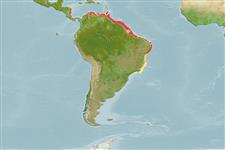>
Eupercaria/misc (Various families in series Eupercaria) >
Sciaenidae (Drums or croakers)
Etymology: Cynoscion: Greek, kyon = dog + Greek, odous = teeth + Greek, skion, skiaina = barbel, red mullet (Ref. 45335).
More on author: Cuvier.
Environment: milieu / climate zone / depth range / distribution range
Ecología
marino; salobre demersal; rango de profundidad 6 - 70 m (Ref. 3702). Tropical; 14°N - 24°S, 84°W - 34°W
Western Atlantic: Nicaragua to Santos, Brazil.
Tamaño / Peso / Age
Maturity: Lm ? range ? - ? cm
Max length : 115 cm TL macho / no sexado; (Ref. 40637); common length : 65.0 cm TL macho / no sexado; (Ref. 3702); peso máximo publicado: 4.4 kg (Ref. 125970)
Espinas dorsales (total): 11; Radios blandos dorsales (total): 27-31; Espinas anales 2; Radios blandos anales: 8. Greyish to brownish above, silvery below. Upper sides sometimes with inconspicuous minute dark dots. Dorsal fin dusky, its spinous portion black-edged. Soft dorsal fin with dark spots on each ray. Pectoral and pelvic fins as well as anal fin yellowish to orange. Caudal fin dusky. Inside mouth orange. Mouth large, distinctly oblique, lower jaw projecting. Upper jaw with a pair of large canine-like teeth at tip. Chin without barbels or pores. Snout with 2 marginal pores. Gas bladder with a pair of long, curved, horn-like appendages. Sagitta (large earstone) elongate, with a notch on dorsal margin. Soft portion of dorsal fin membranes unscaled except 2 or 3 rows of scales at base (Ref 51721).
Usually found over sandy mud bottoms in coastal waters near river mouths (Ref. 3702). Adults stay in deep waters during the day and swim to the surface at night (Ref. 35237). Juveniles inhabit estuaries. Marketed fresh; its flesh is of excellent quality (Ref. 3702). Its swim bladder is being used to make glue (Ref. 35237).
Life cycle and mating behavior
Madurez | Reproducción | Puesta | Huevos | Fecundidad | Larva
Cervigón, F., 1993. Los peces marinos de Venezuela. Volume 2. Fundación Científica Los Roques, Caracas,Venezuela. 497 p. (Ref. 9626)
IUCN Red List Status (Ref. 130435)
Threat to humans
Harmless
Human uses
Pesquerías: comercial; pesca deportiva: si
Más información
Nombres comunesSinónimosMetabolismoDespredadoresEcotoxicologíaReproducciónMadurezPuestaAgregación para la puestaFecundidadHuevosEgg development
ReferenciasAcuiculturaPerfil de acuiculturaRazasGenéticaElectrophoresesheritabilidadEnfermedadesProcesamientoNutrientsMass conversion
ColaboradoresImágenesStamps, Coins Misc.SonidosCiguateraVelocidadTipo de nataciónSuperficie branquialOtolitosCerebrosVisión
Herramientas
Special reports
Download XML
Fuentes de Internet
Estimates based on models
Preferred temperature (Ref.
123201): 26.7 - 28, mean 27.4 °C (based on 112 cells).
Phylogenetic diversity index (Ref.
82804): PD
50 = 0.5000 [Uniqueness, from 0.5 = low to 2.0 = high].
Bayesian length-weight: a=0.00661 (0.00531 - 0.00822), b=3.06 (3.04 - 3.08), in cm total length, based on LWR estimates for this species (Ref.
93245).
Nivel trófico (Ref.
69278): 4.0 ±0.70 se; based on food items.
Resiliencia (Ref.
120179): Bajo, población duplicada en un tiempo mínimo de 4.5-14 años (Preliminary K or Fecundity.).
Prior r = 0.26, 95% CL = 0.14 - 0.46, Based on 1 stock assessment.
Fishing Vulnerability (Ref.
59153): High to very high vulnerability (69 of 100).
Nutrients (Ref.
124155): Calcium = 67.7 [40.4, 126.2] mg/100g; Iron = 0.787 [0.413, 1.359] mg/100g; Protein = 18.5 [17.0, 20.3] %; Omega3 = 0.208 [0.114, 0.339] g/100g; Selenium = 65.4 [34.7, 122.1] μg/100g; VitaminA = 13.3 [5.1, 37.4] μg/100g; Zinc = 0.939 [0.680, 1.330] mg/100g (wet weight);
